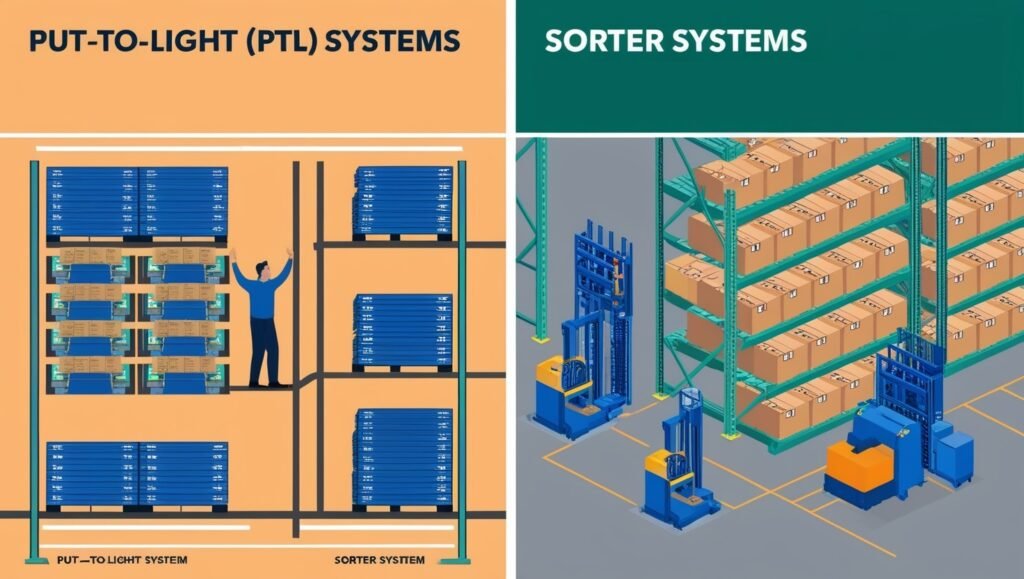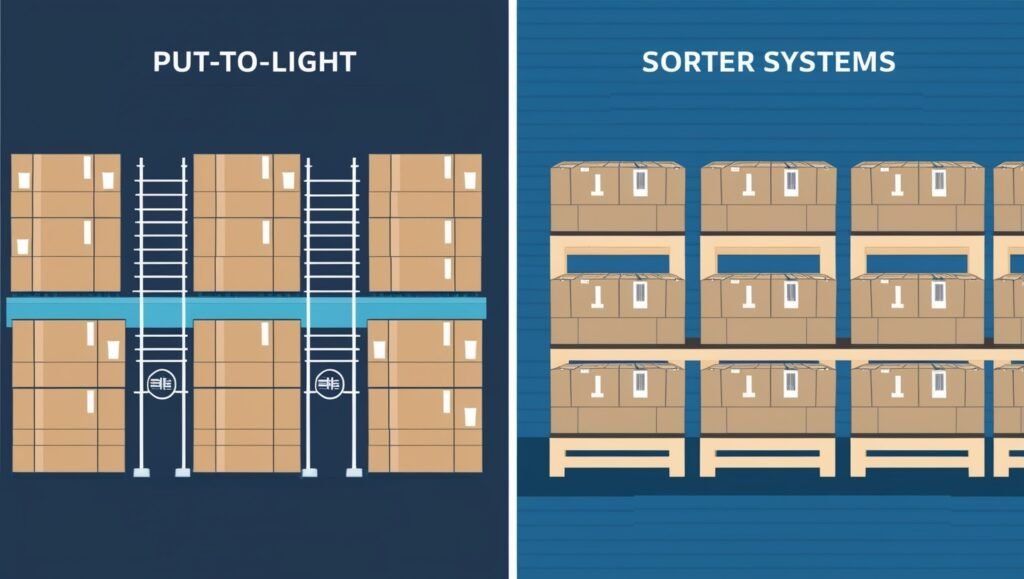- Introduction Put-to-Light and Sorter
- Understanding Put-to-Light Systems
- Understanding Sorter Systems
- Key Differences Between Put-to-Light and Sorter Systems
- Conclusion Put-to-Light and Sorter
- Frequently Asked Questions Put-to-Light and Sorter
- Working of Put-to-Light and Sorter
- What is a Put-to-Light System in Warehousing?
- How does a put-to-light system work?
- What is a sorter system in warehousing?
- How does a sorter system work?
- Applications used in Put-to-Light and Sorter
- What are the primary applications of put-to-light systems?
- What are the primary applications of sorter systems?
- Advantages of Put-to-Light and Sorter
- What are the main advantages of put-to-light systems?
- What are the main advantages of sorter systems?
- Difference between Put-to-Light and Sorter
- How do put-to-light and sorter systems differ in operations?
- Which system is better for high-volume operations?
- Which system is more flexible to changing order profiles?
- Can put-to-light and sorter systems be used together?
- Which system is more suitable for e-commerce fulfillment centers?
- Which system is more suitable for parcel delivery centers?
- Decision between Put-to-Light and Sorter
- How do I choose between a put-to-light and a sorter system for my warehouse?
- Is there a cost difference between put-to-light and sorter systems?
Introduction Put-to-Light and Sorter
In the fast-paced world of warehousing and logistics, efficiency and accuracy are supreme. Two popular technologies that help achieve these goals are put-to-light systems and sorters. While both are designed to streamline sorting and distribution processes, they work differently and are suitable for different types of tasks. This blog will discuss the differences between put-to-light and sorter systems in depth, highlighting their respective benefits and applications.

Understanding Put-to-Light Systems
Put-to-light (PTL) systems are an order fulfillment technology designed to increase the speed and accuracy of sorting items into specific orders or destinations. Here’s how they work:
Operational Mechanism:
Light Indicator: PTL systems use light indicators at different locations (usually bins or shelves) to tell the operator where to place items. When an item needs to be placed in a specific location, a light lights up at that location, guiding the operator to it.
Confirmation button: Once the item is placed, the operator confirms the action by pressing the button associated with the light indicator.
Applications:
Order consolidation: PTL systems are ideal for scenarios where items from multiple orders need to be consolidated. For example, in e-commerce fulfillment centers, items from different orders coming from different picking zones can be directed to the correct order bin using PTL.
Kitting operations: In manufacturing, PTL can be used to assemble kits by guiding operators to place specific components in designated kits.
Benefits:
Increased accuracy: Visual cues reduce errors, ensuring items are placed in the correct locations.
Speed: Operators can work faster because they are directed directly to the appropriate bin, reducing the need for manual searching.
Flexibility: PTL systems can be easily reconfigured for different products or order profiles.

Understanding Sorter Systems
On the other hand, sorter systems are automated systems designed to sort items into specific categories or destinations. Here’s how they work:
Operational Mechanism:
Conveyor Belts: Sorters use conveyor belts to transport items through the sorting system.
Sorting Mechanism: As items move along the conveyor, they are identified (often through barcode scanning) and directed to the correct destination using various mechanisms such as pushers, tilt trays, or cross-belt sorters.
Applications:
Parcel Sorting: In parcel delivery centers, sorters are used to direct packages into different shipping lanes based on their destinations.
Inventory Management: In warehouses, sorters help classify items into different storage areas based on product type, size, or other criteria.
Advantages:
High Throughput: Sorter systems can handle large volumes of items quickly, making them suitable for high-capacity operations.
Reduced Labor: Automation reduces the need for manual intervention, lowering labor costs and reducing the chance of human error.
Scalability: Sorters can be scaled to handle increased volumes, making them a long-term solution for growing businesses.

Key Differences Between Put-to-Light and Sorter Systems
While both PTL and sorter systems aim to improve efficiency and accuracy, their main differences lie in their operations, applications, and benefits:
Operations:
PTL Systems: Rely on visual indicators to guide manual placement of items.
Sorter Systems: Use automated mechanisms to guide items to their destination.
Applications:
PTL Systems: Best suited for order consolidation and kitting operations where human intervention is beneficial.
Sorter Systems: Ideal for high-volume sorting tasks such as parcel sorting and inventory classification.
Advantages:
PTL Systems: Offer flexibility and are easy to reconfigure for different tasks.
Sorter Systems: Offer high throughput and scalability with low labor requirements.
Conclusion Put-to-Light and Sorter
Choosing between put-to-light systems and sorter systems largely depends on the specific needs of your warehousing operation. PTL systems are excellent for tasks that require human intervention and flexibility, while sorters are the go-to solution for high-volume, automated sorting tasks. Understanding the strengths and applications of each system will help you make an informed decision, which will ultimately increase the efficiency and accuracy of your warehousing operations.
Frequently Asked Questions Put-to-Light and Sorter
Working of Put-to-Light and Sorter
What is a Put-to-Light System in Warehousing?
A put-to-light (PTL) system is a technology used in warehousing to aid order fulfillment. It uses light indicators to direct the operator to the correct bins or shelves where items need to be placed. This system increases the speed and accuracy of sorting items into specific orders or destinations.
How does a put-to-light system work?
PTL systems use light indicators at different locations (bins or shelves). When an item needs to be placed in a specific location, the corresponding light illuminates, guiding the operator. The operator then places the item and confirms the action by pressing the button associated with the light indicator.
What is a sorter system in warehousing?
A sorter system is an automated technology used to sort items into specific categories or destinations. It uses conveyor belts to carry items and various mechanisms (such as pushers, tilt trays or cross-belt sorters) to direct the items to their correct locations.
How does a sorter system work?
Sorter systems transport items along conveyor belts. As items pass through the system, they are identified (often through barcode scanning) and directed to the correct destination using automated mechanisms. This process reduces manual intervention and increases the speed of sorting.
Applications used in Put-to-Light and Sorter
What are the primary applications of put-to-light systems?
PTL systems are primarily used for order consolidation and kitting operations. They are ideal for scenarios where items from multiple orders need to be consolidated or where specific components need to be assembled into a kit.
What are the primary applications of sorter systems?
Sorter systems are used for high-volume sorting operations, such as parcel sorting in delivery centers and inventory classification in warehouses. They handle large volumes of items quickly and efficiently.
Advantages of Put-to-Light and Sorter
What are the main advantages of put-to-light systems?
Increased accuracy: Visual cues reduce errors, ensuring correct item placement.
Speed: Operators are directed directly to the appropriate bin, reducing search time.
Flexibility: Easy reconfiguration for different products or order profiles.
What are the main advantages of sorter systems?
High throughput: Handles large volumes of items quickly.
Reduced labor: Automation reduces the need for manual intervention and potential human error.
Scalability: Can be scaled to handle increased volumes, making them suitable for growing businesses.
Difference between Put-to-Light and Sorter
How do put-to-light and sorter systems differ in operations?
Put-to-light systems: Rely on visual indicators to guide manual placement of items by operators.
Sorter systems: Use automated mechanisms to guide items to their destination without manual intervention.
Which system is better for high-volume operations?
Sorter systems are better suited for high-volume operations because they have the ability to handle large volumes of items quickly and efficiently with minimal manual labor.
Which system is more flexible to changing order profiles?
Put-to-light systems are more flexible to changing order profiles because they can be easily reconfigured to accommodate different products and order requirements.
Can put-to-light and sorter systems be used together?
Yes, put-to-light and sorter systems can be used together in a complementary manner. For example, the sorter system can handle high-volume sorting of items into common categories, and then the PTL system can be used for the final order consolidation or kitting process.
Which system is more suitable for e-commerce fulfillment centers?
Put-to-light systems are often more suitable for e-commerce fulfillment centers because they facilitate order consolidation, where items from different orders coming from different picking zones need to be directed to the correct order bins.
Which system is more suitable for parcel delivery centers?
Sorter systems are more suitable for parcel delivery centers because they efficiently handle high-volume sorting of packages into different shipping lanes based on their destinations.
Decision between Put-to-Light and Sorter
How do I choose between a put-to-light and a sorter system for my warehouse?
The choice depends on your specific needs: If you need high-volume, automated sorting with minimal manual intervention, a sorter system is ideal. If you need flexibility, easy reconfiguration, and functions that benefit from human intervention, such as order consolidation and kitting, a put-to-light system is more suitable.
Is there a cost difference between put-to-light and sorter systems?
Sorter systems typically involve higher initial costs due to their automated nature and the need for extensive conveyor infrastructure. Put-to-light systems may have lower initial costs, but may incur higher labor costs due to the need for manual operations. The overall cost-effectiveness depends on the specific needs and scale of your warehousing operation.
